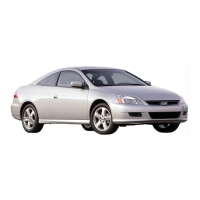
Do you have a question about the Honda 2010 Accord Coupe and is the answer not in the manual?
| Brand | Honda |
|---|---|
| Model | 2010 Accord Coupe |
| Category | Automobile |
| Language | English |
Key safety recommendations considered most important for safe driving and vehicle condition.
Explanation of why wear seat belts, their effectiveness in various crash types, and proper usage.
Information on SRS front, side, and curtain airbags: their components and how they work.
General guidelines and specific advice for properly restraining infants, small children, and larger children in vehicles.
Location and function of controls mounted on or near the steering wheel for driver convenience.
Detailed explanation of the climate control system, including fan, temperature, mode, and recirculation controls.
Explanation of automatic and manual climate control operation, dual temperature, and SYNC button functions.
Guide to using the standard audio system, including FM/AM radio, XM Radio, and disc playback features.
Instructions for pairing, using, and managing phone calls with the Bluetooth HandsFreeLink system.
Guidelines for the initial driving period to ensure vehicle reliability and performance, and recommended gasoline.
Explanation of the braking system design, wear indicators, and how to check brake fluid and pads.
How ABS works to prevent wheel lock-up, what to expect during activation, and the function of the ABS indicator.
How VSA helps stabilize the vehicle during cornering and assists traction, including VSA activation and OFF switch.
Explanation of the TPMS, the low tire pressure indicator, and what to do when the indicator illuminates.
Guidelines for towing a trailer, including load limits, equipment, safety chains, trailer brakes, and driving techniques.
Explanation of the maintenance minder system, how to read messages, and reset the engine oil life display.
Detailed information on tire care, including inflation, inspection, replacement, rotation, and wheel specifications.
Step-by-step instructions for safely changing a flat tire, including tool usage, jack operation, and wheel nut tightening.
Troubleshooting guide for engine starting issues, covering starter motor operation and potential causes like battery or fuel problems.
Procedure for safely jump starting a vehicle using jumper cables and a booster battery, with warnings and precautions.
What to do if the engine overheats, including checking for steam, coolant leaks, and safe procedures for cooling down.
Meaning of the low oil pressure indicator, immediate actions to take, and consequences of low oil pressure.
What the charging system indicator means, and actions to take when the battery is not being charged.
Explanation of the malfunction indicator lamp (check engine light), its causes, and the importance of readiness codes.
Meaning of the brake system indicator, what to do if it comes on while driving, and when to seek service.
Instructions on how to properly tow the vehicle in an emergency, including flat-bed and wheel-lift equipment use.
Explanation of the TPMS, its function, the low tire pressure telltale, and required federal explanation.












